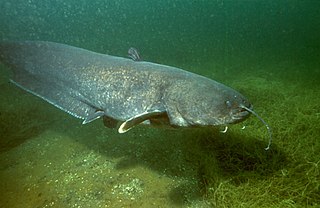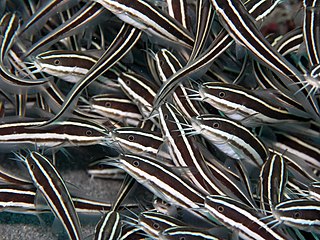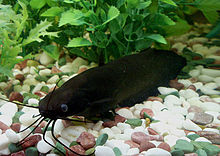
Catfish are a diverse group of ray-finned fish. Named for their prominent barbels, which resemble a cat's whiskers, catfish range in size and behavior from the three largest species alive, the Mekong giant catfish from Southeast Asia, the wels catfish of Eurasia, and the piraíba of South America, to detritivores, and even to a tiny parasitic species commonly called the candiru, Vandellia cirrhosa. Neither the armour-plated types nor the naked types have scales. Despite their name, not all catfish have prominent barbels or "whiskers". Members of the Siluriformes order are defined by features of the skull and swimbladder. Catfish are of considerable commercial importance; many of the larger species are farmed or fished for food. Many of the smaller species, particularly the genus Corydoras, are important in the aquarium hobby. Many catfish are nocturnal, but others are crepuscular or diurnal.

The Folsom Lake State Recreation Area surrounds Folsom Lake in the foothills of the Sierra Nevada. The majority of it is owned by the U.S. Bureau of Reclamation and is managed by the California Department of Parks and Recreation. It is located near the city of Folsom, California, about 25 miles (40 km) east of Sacramento.

The Ictaluridae, sometimes called ictalurids, are a family of catfish native to North America, where they are an important food source and sometimes fished for sport. The family includes about 51 species, some commonly known as bullheads, madtoms, channel catfish, and blue catfish.

The brown bullhead is a fish of the family Ictaluridae that is widely distributed in North America. It is a species of bullhead catfish and is similar to the black bullhead and yellow bullhead. It was originally described as Pimelodus nebulosus by Charles Alexandre Lesueur in 1819, and is also referred to as Ictalurus nebulosus.

The walking catfish is a species of freshwater airbreathing catfish native to Southeast Asia. It is named for its ability to "walk" and wiggle across dry land, to find food or suitable environments. While it does not truly walk as most bipeds or quadrupeds do, it can use its pectoral fins to keep it upright as it makes a wiggling motion with snakelike movements to traverse land. This fish normally lives in slow-moving and often stagnant waters in ponds, swamps, streams, and rivers, as well as in flooded rice paddies, or temporary pools that may dry up. When this happens, its "walking" skill allows the fish to move to other aquatic environments. Considerable taxonomic confusion surrounds this species, and it has frequently been confused with other close relatives. One main distinction between the walking catfish and the native North American ictalurid catfish with which it is sometimes confused, is that the walking catfish lacks an adipose fin. It can survive 18 hours out of water.

The Mekong giant catfish, is a large, threatened species of catfish in the shark catfish family (Pangasiidae), native to the Mekong basin in Southeast Asia and adjacent China. It is considered critically endangered due to overfishing and habitat loss.

The eel-tailed catfish is a species of catfish of the family Plotosidae. This fish is also known as dewfish, freshwater catfish, jewfish, and tandan.

The wels catfish, also called sheatfish or just wels, is a large species of catfish native to wide areas of central, southern, and eastern Europe, in the basins of the Baltic, Black and Caspian Seas. It has been introduced to Western Europe as a prized sport fish and is now found from the United Kingdom east to Kazakhstan and China and south to Greece and Turkey.

The redtail catfish, is a large species of South American pimelodid (long-whiskered) catfish. It is known in Venezuelan Spanish as cajaro; in Guyana, it is known as a banana catfish, and in Brazil it is known as pirarara, a fusion of words from the indigenous Tupi language: pirá and arara. It is the only extant species of its genus, Phractocephalus.

The black bullhead or black bullhead catfish is a species of bullhead catfish. Like other bullhead catfish, it has the ability to thrive in waters that are low in oxygen, brackish, turbid, and/or very warm. It also has barbels located near its mouth, a broad head, spiny fins, and no scales. It can be identified from other bullheads as the barbels are black, and it has a tan crescent around the tail. Its caudal fin is truncated. Like virtually all catfish, it is nocturnal, preferring to feed at night, although young feed during the day. It generally does not get as large as the channel or blue catfish, with average adult weights are in the 1-to-2-pound range, and almost never as large as 4 pounds (1.8 kg). It has a typical length of 6–14 inches (15–36 cm), with the largest specimen being 24 inches (61 cm), making it the largest of the bullheads. It is typically black or dark brown on the dorsal side of its body and yellow or white on the ventral side.

Wallago attu, the boal or helicopter catfish is a freshwater catfish of the family Siluridae, native to South and Southeast Asia. W. attu is found in large rivers and lakes in two geographically disconnected regions, with one population living over much of the Indian Subcontinent and the other in parts of Southeast Asia. This species can reach a length up to 1.1 m.

Pterygoplichthys gibbiceps is a species of armored catfish native to Brazil, Ecuador, Peru and Venezuela where it is found in the Orinoco and Amazon basins.

The weatherfish is a species of true loach that has a wide range in Europe and some parts of Asia. It is an omnivorous scavenger bottom feeder, using its sensitive barbels to find edible items. The diet mostly consists of small aquatic invertebrates along with some detritus. The weatherfish is long and thin which allows it to burrow through the substrate and navigate through places that deeper bodied fish would have trouble with. It grows up to 30 cm (12 in) in total length, though there are fishermen who say they have caught longer, up to 45 cm (17.7 in). If true, this would make Misgurnus fossilis the largest species of true loach.

Plotosus is a genus of eeltail catfishes native to the Indian Ocean, the western Pacific Ocean and New Guinea.

Heteropneustes is a genus of catfishes, the airsac catfishes, native to Asia. This genus is monotypic in the family Heteropneustidae.

The frecklebelly madtom is a species of fish in the family Ictaluridae endemic to the United States. Madtoms are in the genus Noturus, which is a group of catfish prevalent in North America. In 2023, the Upper Coosa River distinct population segment (DPS) of N. munitus was listed as federally threatened under the Endangered Species Act of 1973.

The broadhead catfish is an economically important air-breathing catfish that is a native of Southeast Asia. The fish is farmed in ponds for use in human consumption in countries such as Thailand and the Philippines. However, native populations now face extinction due to man-made activities and genetic introgression due to interbreeding with escaped aquaculture hybrids.

Neoarius graeffei, or blue salmon catfish, is a species of catfish found in freshwater rivers of Australia and Papua New Guinea. This species is most identifiable by its large, shark-like dorsal fin that is led by a poisonous spine. Like other catfish, the blue salmon catfish is known to use electrical pulses to sense prey in the water. This prey sensing mechanism may be the reason that these catfish are known to eat the land dwelling hopping mouse at a high rate.

Kapla Beel is a wetland and lake located towards the south of Baniyakuchi-Haladhibari under Sarthebari revenue circle in Barpeta district of Assam.





















